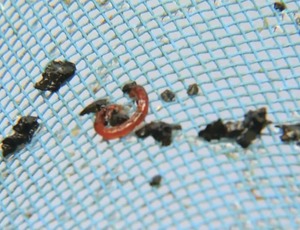
Residents in Colcord, Okla., are still observing a water-use advisory as town officials flush out tiny red worms that made their way into the city's drinking-water supply last month.
The town's approximately 800 residents and local businesses were told not to use tap water for cooking or drinking and, instead, use bottled water until state and local officials are certain the worm problem has been resolved.
The red worms—or blood worms, which range in length from about a half inch to an inch long—aren't necessarily a human health risk, says the Centers for Disease Control and Prevention. But the state's Dept. of Environment Quality has advised the town, located about 80 miles east of Tulsa, to hold off on water use while all traces of the worms are expelled.
Filter Flap
After investigating the infestation, the Oklahoma DEQ determined that the red worms wiggled their way into the water supply after midge flies entered the system through sand filters at the water treatment plant, says agency spokeswoman Erin Hatfield. "The life cycle of the midge fly includes four stages: egg, larvae [red worms], pupae and adult. The non-biting midge flies laid their eggs in the filter, which produced the resulting red worms that then entered the water supply," she explains.
After the blood worms first appeared on Aug. 26, DEQ and the city of Colcord have been working to clean the filters and flush the distribution and household lines and hot-water tanks, Hatfield says. The city also flushed its water tower, but it was already free of the invaders.
Red worms are common in the southeastern U.S., but an actual infestation of red worms in a city's water distribution system is rare.
"As far as we know, it has only happened one other time in the state, and that was in Drumright, Okla., approximately 20 to 30 years ago," Hatfield says. Drumright is about 120 miles west of Colcord.
In order to keep the problem from reoccurring, the DEQ says it is working with the city to ensure that all possible entry points to the water treatment plant are protected by means such as screens covering the filters.
"DEQ has taken into account the possibility of reinfestation and, therefore, will continue to work with the town throughout the duration of the expected life cycle of the red worm before advising the town to lift the precautionary water-use advisory," Hatfield adds.



Post a comment to this article
Report Abusive Comment